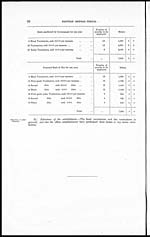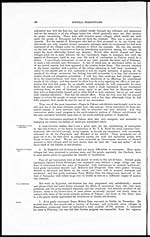Medicine - Vaccination > 1869-1873 - Report on vaccination in the Province of Bengal > Report on vaccination in the Province of Bengal for the year ending 31st March 1873
(434) [Page 39]
Download files
Individual page:
Thumbnail gallery: Grid view | List view
![(89) [Page 39] -](https://deriv.nls.uk/dcn17/9153/91535924.17.jpg)
The sixth annual report of Vaccination in the Sonthal Pergunnahs.
By SUB-ASSISTANT SURGEON KALI KRISHNA GHOSE, Deputy Superintendent.
Establishment
1. The establishment continued the same as last year, i e., one deputy superintendent
and six vaccinators; the latter being arranged in grades; thus one in the first grade on a
salary of Rs. 16 per month employed rate, and Rs. 12 per month unemployed rate; 2 in
the second grade on Rs. 13 and 10 ; and three in the third grade on Rs. 10 and 8. There
were no changes among these.
Plan of work
Field of operation
2. On the approach of the season, being fully alive to the importance of systematic
action, I arranged my vaccinators, so that the areas vaccinated may, as far as practicable,
be an extension of those of previous years. I accordingly obtained the consent of the
civil surgeon, Sonthal Pergunnahs, to commence work in the remaining unprotected por-
tions of Rajmehal, as well as in the interior of Pakour, and, if possible, gradually to
extend it towards Godda on one side, or Doomka on the other.
Introduction of vac-
cination into Pa-
kour.
Difficulties experi-
enced
3. In the sub-division of Rajmehal, a large number of villages having been gone
through in former years, the work of introduction was not a matter of difficulty. But in
Pakour a very few villages only were, for the first time, protected by vaccination last year,
and those were chiefly located by the side of the railway line, none of the principal
villages in the interior having been touched. This year I proposed to commence work in
such of the principal villages in the interior, as might, by their position and so forth,
exercise a favorable influence on the progress of vaccination. And as great opposition was
anticipated at the outset, I set two of my expert vaccinators; viz, Indro Narain Dass and
Rutty Kanto Dass (the one a second grade and the other a third grade vaccinator) to work in
these places. A circumstance occurred which facilitated the introduction of the work here.
A report of small-pox (which afterwards turned out to be false) was made by the inhabitants
of a certain village, named Bissenpore in the interior of Pakour. I went there accom-
panied by one of my vaccinators, and found that a few deaths had occurred from dysentry
and fever, which certain people of the village attributed to small-pox. They said that an
inoculator, by name Megh Roy, had performed inoculation in their village last year, that
this had not given rise to the usual erruption of small-pox, which had accordingly lain
latent in the system, and now appeared in the shape of bloody discharge from the intestines
and so forth. I did not think of at once disabusing their minds of this false impression,
but took advantage of it for the purpose of introducing vaccination and of winning over
to our side the inoculator named. I offered the people hopes of protection from the dire
mortality with which they were threatened and they accordingly agreed to my proposals.
Thus on the 3rd October 1872, vaccination was introduced in one village in the interior of
Pakour. This village was made the centre from which our operations were to proceed on all
sides. A few weeks afterwards it was found however, that vaccination was making but slow
progress in a few insignificant villages of this quarter. My object was to gain over some
of the principal villages whose example might serve to stimulate the rest and thus render
its progress easy. In one of my inspections I was told that the Purgonyte of Sohori, an
influential man among the Sonthals of that quarter, was offering great opposition to vacci-
nation. This man had a number of villages under him, the people of which would only
follow his example. I accordingly went over to Sohori and tried all arts of persuasion but
to no effect. The headmen of the village were inexorable. I then instructed my vacci-
nators to win over such villages as readily yielded, so that no time might be lost in estab-
lishing vaccination in a certain number of them. Then on a subsequent visit I went over
a second time to Sohori and after much effort succeeded in getting a child, belonging to the
Desh Manjee or the second man in the village, vaccinated. This done, the rest of the
people afterwards came forward of their own accord.
The introduction of vaccination in this village facilitated its progress in many others
which were under its jurisdiction, till by gradual marches southward we came upon Heran-
pore which is one of the most populous and important villages in the interior of Pakour sub-
division. Here the population is composed chiefly of Hindus; the mundel Heru Seal is
reckoned as a man of influence; and there is a class of people called moyras who have
all along been the most inveterate opponents of vaccination. I had once, in the month
of October, called on this mundel for the purpose of introducing vaccination in his village,
but he had then told us to put off till the month of Kartick (which was an evil month
with the Hindus) was over. My vaccinators were in the meantime busily engaged in
carrying on work in such of the surrounding villages as they could win over. Another
Purgonyte of the village of Sarsa, a few miles to the south-west of Heranpore, an equally
Set display mode to: Large image | Zoom image | Transcription
Images and transcriptions on this page, including medium image downloads, may be used under the Creative Commons Attribution 4.0 International Licence unless otherwise stated. ![]()
| India Papers > Medicine - Vaccination > Report on vaccination in the Province of Bengal > Report on vaccination in the Province of Bengal for the year ending 31st March 1873 > (434) [Page 39] |
|---|
| Permanent URL | https://digital.nls.uk/91535922 |
|---|
| Additional NLS resources: | |
|---|---|




